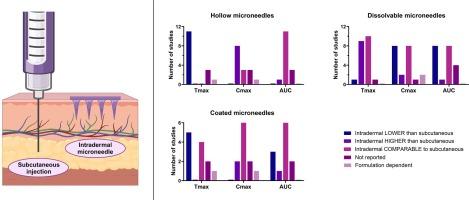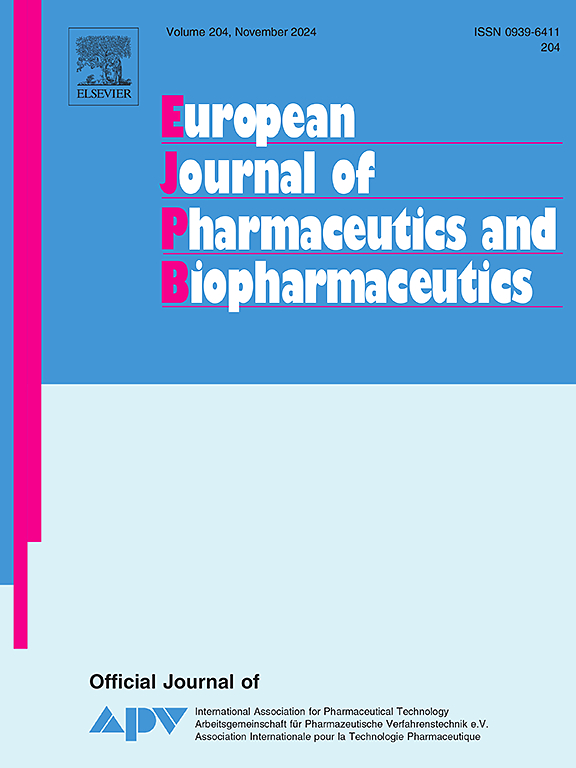皮下注射和皮内微针给药的药代动力学差异。
IF 4.4
2区 医学
Q1 PHARMACOLOGY & PHARMACY
European Journal of Pharmaceutics and Biopharmaceutics
Pub Date : 2024-09-28
DOI:10.1016/j.ejpb.2024.114517
引用次数: 0
摘要
蛋白质疗法是治疗各种疾病的重要手段,但其中大多数需要肠外给药。由于静脉注射和皮下注射会带来不适和疼痛,因此人们研究了其他途径,包括皮内微针给药。微针比皮下注射针头短,因此能最大限度地减少与皮肤深层痛觉感受器的接触。但真皮层和皮下组织在解剖和生理特点上的差异可能会导致蛋白质在皮肤中的渗透、吸收和新陈代谢出现差异。本综述总结了通过皮下注射和不同类型的微针(包括空心微针、可溶微针、涂层微针和水凝胶微针)在皮肤内给药的药代动力学研究比较。在动物和人体研究中,空心微针给药使蛋白质的血浆峰值水平更快更高,生物利用度与皮下注射相当,这可能是由于真皮层有广泛的淋巴和血管网络。对于可溶解和涂层微针,药物释放动力学取决于组成材料。聚合物辅料的溶解会减缓蛋白质治疗药物在给药部位的释放和渗透,从而延迟吸收。人们对药物在不同皮肤层的渗透、毛细血管或淋巴管的吸收以及皮肤新陈代谢的了解仍然有限。此外,这些过程对皮内微针给药后蛋白质药代动力学特征差异的影响也不甚了解。开发新一代皮内微针生物治疗药物需要更深入的了解。本文章由计算机程序翻译,如有差异,请以英文原文为准。

Pharmacokinetic differences between subcutaneous injection and intradermal microneedle delivery of protein therapeutics
Protein therapeutics are essential in the treatment of various diseases, but most of them require parenteral administration. Since intravenous and subcutaneous injections are associated with discomfort and pain, other routes have been investigated including intradermal microneedle delivery. Microneedles are shorter than hypodermic needles and therefore minimize contact with pain receptors in deeper skin layers. But the differences in anatomical and physiological characteristics of dermis and subcutis can potentially result in varying protein penetration through the skin, absorption, and metabolism. This review summarizes pharmacokinetic studies that compare the administration of protein therapeutics by subcutaneous injections and different types of microneedles intradermally including hollow, dissolvable, coated, and hydrogel-forming microneedles. Across animal and human studies, hollow microneedle delivery resulted in quicker and higher peak plasma levels of proteins and comparable bioavailability to subcutaneous injections potentially due to the extensive network of lymphatic and blood vessels in the dermis. In case of dissolvable and coated microneedles, drug release kinetics depend on component materials. The dissolution of polymer excipients can slow the release and permeation of protein therapeutics at the administration site and thereby delay absorption. The understanding of drug penetration through different skin layers, its absorption into blood capillaries or lymphatics, and dermal metabolism remains limited. Additionally, the effects of these processes on the differences in pharmacokinetic profiles of proteins following intradermal microneedle administration are not well understood. Greater insights are required for the development of the next generation of intradermal microneedle biotherapeutics.
求助全文
通过发布文献求助,成功后即可免费获取论文全文。
去求助
来源期刊
CiteScore
8.80
自引率
4.10%
发文量
211
审稿时长
36 days
期刊介绍:
The European Journal of Pharmaceutics and Biopharmaceutics provides a medium for the publication of novel, innovative and hypothesis-driven research from the areas of Pharmaceutics and Biopharmaceutics.
Topics covered include for example:
Design and development of drug delivery systems for pharmaceuticals and biopharmaceuticals (small molecules, proteins, nucleic acids)
Aspects of manufacturing process design
Biomedical aspects of drug product design
Strategies and formulations for controlled drug transport across biological barriers
Physicochemical aspects of drug product development
Novel excipients for drug product design
Drug delivery and controlled release systems for systemic and local applications
Nanomaterials for therapeutic and diagnostic purposes
Advanced therapy medicinal products
Medical devices supporting a distinct pharmacological effect.

 求助内容:
求助内容: 应助结果提醒方式:
应助结果提醒方式:


